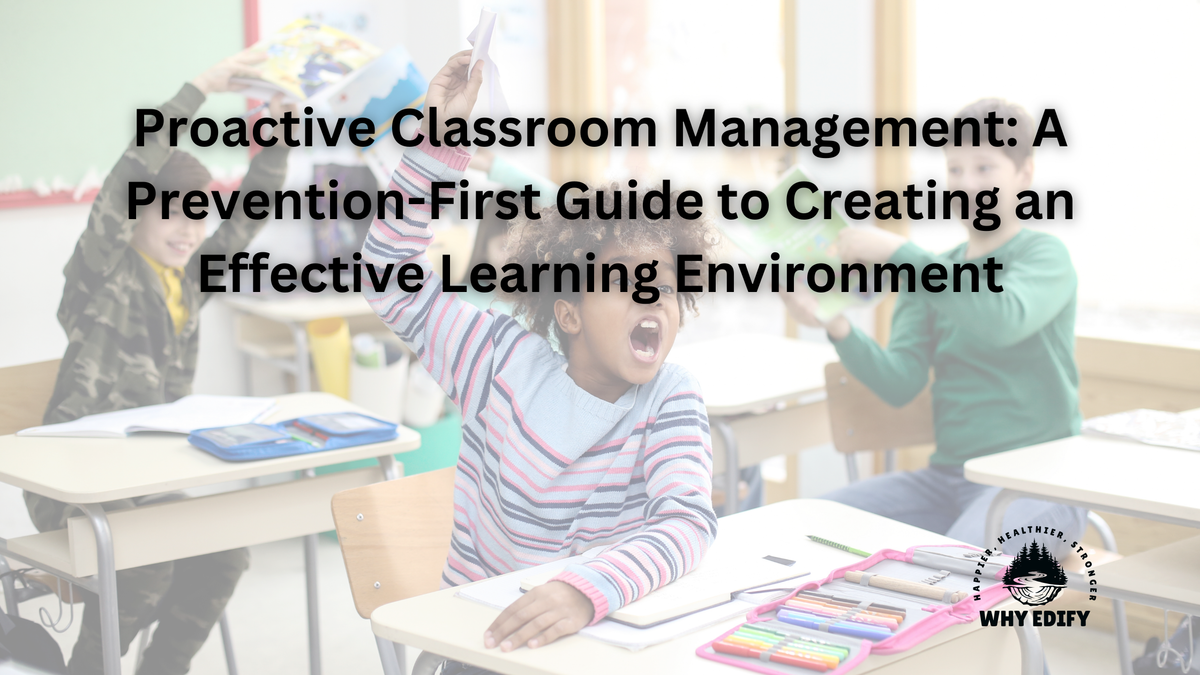Proactive Classroom Management: A Prevention-First Guide to Creating an Effective Learning Environment
Discover research-backed proactive classroom management strategies that reduce behavioral issues by 80%. Learn practical tips for strategic seating, non-verbal cues, active supervision, and thorough planning to create a positive learning environment.

Proactive Classroom Management: A Prevention-First Guide to Creating an Effective Learning Environment
Support Why EdifyGood teachers know that managing a classroom well means stopping problems before they start, not just dealing with them after they happen. Like a coach who plans out plays before a game, teachers who use strategies to prevent issues create better classrooms where students can focus on learning without getting distracted. This proactive approach requires careful planning and consistent implementation, but the results are worth the effort. According to a study by Oliver et al. (2019) in the Journal of Positive Behavior Interventions, teachers who focus on prevention spend up to 80% less time dealing with behavioral issues. Most importantly, when students know what to expect and feel supported, they're more likely to engage meaningfully with the learning process.
Let's explore key proactive strategies that can transform your classroom management:
The Foundation of Prevention
Preventive management is about creating structures and routines that naturally encourage positive behavior. Think of it as setting up your classroom's immune system - minor disruptions rarely become major issues when it's strong. This approach requires thoughtful planning and consistent implementation, but the investment pays off in dramatically reduced behavior issues and increased learning time.
Strategic Seating: More Than Just a Seating Chart
Your classroom's seating arrangement is a powerful management tool. Consider factors like:
- Traffic patterns that minimize disruptions during transitions - Design paths between desks, cubbies, and activity areas that allow smooth movement. Create wide lanes near high-traffic areas like pencil sharpeners and materials stations. Consider placing frequently accessed resources at multiple points to prevent bottlenecks.
- Student combinations that promote positive peer interactions - Strategically pair students based on academic abilities, social dynamics, and learning styles. Consider rotating seating arrangements monthly to foster new relationships while maintaining productive working relationships. Keep students who may distract each other separated but within your line of sight.
- Clear sightlines for active supervision - Position your desk or teaching station where you can see all the students. Arrange furniture to eliminate blind spots and ensure you can make eye contact with every student. Keep shelving and displays at a height that doesn't block views of student work areas.
- Flexible grouping options for different learning activities - Create modular seating arrangements that can easily transition between whole group, small group, and individual work. Use furniture that can be quickly reconfigured for different activities. Designate specific areas for different types of group work and maintain clear procedures for moving between configurations.
Visual and Auditory Cues: Silent Signals for Smooth Transitions
Develop a system of non-verbal cues to maintain flow without interrupting instruction. This might include:
- Hand signals for everyday needs: Create clear, simple gestures for frequent requests like bathroom breaks (e.g., raising 1 finger), water fountain visits (e.g., making a 'W' with fingers), or asking questions (e.g., raising thumb). Teach these signals explicitly and post visual reminders until they become routine.
- Visual timers for time management: Use digital displays, sand timers, or progress bars to help students track time during activities—display countdown clocks during transitions, independent work, or group discussions. Consider using color-coded zones (green = plenty of time, yellow = wrap up, red = time's up) to help students pace themselves.
- Attention signals that respect student dignity: Implement gentle attention-getters like wind chimes, a simple hand raise with a countdown, or a quiet clapping pattern. Avoid loud noises or signals that might embarrass students. Give students 3-5 seconds to respond, acknowledging those who transition quickly.
- Posted schedules and procedures for reference: Create clear, visually appealing charts showing daily routines, transition procedures, and learning center rotations. Include both text and pictures for younger students. Update these regularly and reference them consistently during transitions or when introducing new activities.
Active Supervision: The Art of Being "Withit"
Effective teachers develop what education researchers call "withitness" - the ability to know what's happening in all parts of the classroom at once. This involves:
- Strategic positioning to see all students: Position yourself with clear sightlines to every corner of the room. Avoid turning your back to students for extended periods. When working with small groups, sit or stand where you can still monitor the rest of the class. Consider using elevated areas like stools during whole-group instruction for better visibility.
- Regular movement throughout the classroom: Follow unpredictable patterns while circulating to keep students engaged. Aim to visit each section of the room every 5-10 minutes. Use proximity control by standing near potentially disruptive areas. Move smoothly and quietly to avoid disrupting instruction.
- Scanning for early signs of off-task behavior: Watch for signs like restlessness, wandering eyes, or fidgeting. Monitor student facial expressions and body language that might indicate confusion or disengagement. Pay special attention during transitions and independent work time. Use periodic whole-room visual sweeps (every 2-3 minutes).
- Immediate and quiet intervention when needed: Address issues with subtle redirections like eye contact or gentle desk taps. Use proximity and non-verbal cues before verbal corrections. When verbal intervention is necessary, speak quietly and privately to maintain student dignity. Follow up discreetly to ensure the student is back on track.

The Power of Planning
Thorough planning eliminates many common classroom management issues before they arise. This includes:
- Detailed lesson plans with smooth transitions: Include clear time blocks, transition signals, and step-by-step procedures for moving between activities. Write out specific transition phrases and movement patterns. Plan natural breaks between content segments and include quick engagement strategies like "turn and talk" or "quick write" to maintain momentum.
- Backup activities for early finishers: Create a bank of meaningful extension activities like challenge problems, enrichment reading, or skill-building games. Design these activities to be self-directed and aligned with learning objectives. Include everydayindividual and partner options that can be completed quietly without teacher supervision.
- Materials prepared and organized in advance: Set up labeled bins or folders for each activity, pre-sort materials into student groups, and create supply stations with clear access procedures. Have technology charged and ready, handouts pre-copied, and manipulatives counted out. Create a daily materials checklist to ensure nothing is overlooked.
- Clear procedures for routine tasks: Develop and post step-by-step instructions for everyday activities like turning in work, getting supplies, or transitioning between centers. Include visual aids when possible, practice procedures regularly, and create consistent routines that students can follow independently.
Remember that these strategies work best when you have good relationships with your students, just like the EMR approach teaches us. When you combine these strategies with being positive and helping fix problems when they come up, you create a classroom where students can do their best work.
Think of your classroom like a band playing music together - everything from where students sit to how you get their attention needs to work together smoothly. When you use these strategies to prevent problems before they start, you'll have more time to focus on what's important: helping your students learn.
IMPORTANT - Perfection is unattainable. You can do everything right, but things still won’t go your way. Try not to take it personally. This is the nature of working with variables that are beyond your control - other human beings. I can promise, that with consistency, these classroom management ideas will be helpful.
What are your tried and true tips for managing behaviors? Leave them in a comment below.
❤ Enjoy this Article?
🍵 Show Your Support and 🤗 Share It



